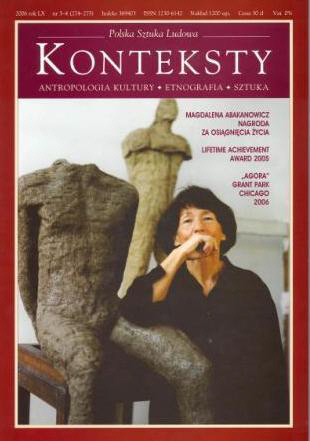|
2006 (rok LX) |
Summaries: |
 |
Zbigniew Benedyktowicz Why Abakanowicz? The answer to the
titular question (and the reason for the publication of this issue)
is obvious. In the autumn of 2005 Magdalena Abakanowicz received the
highest prize awarded to living sculptors by their milieu – the
highly prestigious International Sculpture Centre’s Lifetime
Achievement Award, presented in
The art of Magdalena Abakanowicz possesses its own profound
anthropological, symbolic and universal dimension. In this fashion,
the presented issue, thanks to the collected texts interpreting her
works and the statements made by the artist herself, has become a
significant part of a series of our most recent fascicles on the
anthropology of the image. It also situates itself in the very
centre of our anthropological discussion. Suffice to mention the
realizations of various Abakanowicz projects introduced into the
landscapes of Tuscany, Japan and Lithuania, and more broadly:
Europe, Asia, Australia, and America, to immediately ask about the
way in which this art, so deeply embedded in the individual
experiences of its author and so closely connected with local
culture and experiences, manages to produce such a response among
other cultural environments. If the essence of anthropology lies in
dialogue, then the works of Magdalena Abakanowicz fully deserve to
be described as anthropological art, not merely due to their
dialogical character. Their force also lies, as the authors of many
of the presented texts noted, in
”The validity of the universal view has been challenged and
in many ways stripped of its pre-eminence in recent decades.
Critical theory has deconstructed the universalizing impulse,
revealing it as generalizations of implicit colonialist arrogance.
Culturally specific, site specific, locally specific, community
specific: these are the terms that have come into use to
differentiate peoples, their cultures and their aesthetic
sensibilities. We have recoiled from the “universal” as a functional concept in our multicultural, pluralistic world. Yet some
artists – of which Abakanowicz figures among the very few of our
time – remind us that “universal” is not a passé notion
but an idea essential to the understanding of our humanity. In
revealing the aspects we share, the artist plays a critical role in
society. Through the singular example, Abakanowicz speaks of all in
the genus. A drawing of a flower is never of a particular plant,
just as each of the Faces (1981) in her earliest cycle of
major drawings are never portraits. Rather, the content of her
flowers is of indisputable universal relevance: birth and death,
pain and suffering, endurance and
The editors express their gratitude to all the authors of the
collected texts and the photographs, as well as the publishers whose
consent to include original versions of the texts and their
translations into Polish and English has greatly contributed to the
appearance of this issue. Special thanks go to Danuta Wróblewska
and Wies³awa Wierzchowska for their inspiration and initiative, and
to Ms Katarzyna Staniszewska and Artur Starewicz for their valuable
editorial cooperation.
|
